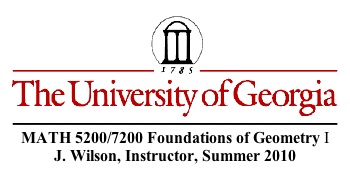

Problem Set 2.3
2.3.1. Construct the locus of all points (in one half plane) from which a given segment (that you can draw) is seen by:
a. 90 degrees
Take the given segment. Construct its midpoint construct a semicircle. The locus of all point (in one half plane) from which the given segment is seen by 90 degrees ins the semicircle with center at the midpoint of the segment.
b. 60 degrees
Construct an equilateral triangle and extend one of the sides. Mark off an arc with a radius of the given segment so that one end of each end of the segment is on a side of the equilateral triangle. A new triangle is created with one 60 degree angle and the side opposite the 60 degree angle is the given segment. Construct the circumcircle and take the arc containing the 60 degree vertex.
c. 120 degrees
Same as in part b, but begin by constructing a 120 degree angle. The locus is a minor arc of the circle because the subtending angle is obtuse.
d. 105 degrees
Begin by constructing a 105 degree angle. I used a rhombus made from two equilateral triangles and bisected angles to gain 60 + 30 + 15 degrees. Then I preceded is the same way as in part b.
2.3.2 See the GSP file. This is Construction 2.3 with a given obtuse angle.
2.3.3 Draw a right triangle and then construct a triangle congruent to it using only a leg, the hypotenuse, and the fact that it is a right triangle. In other words, construct a right triangle, given its hypotenuse and one leg.
Let AB = the hypotenuse and AC the given leg. Then make AB the diameter of a circle, and from A mark off an arc of radius AC. The intersection of the semicircle and the arc will be point C.
Or, construct segment AC and construct a perpendicular from C. Use AB, to mark off an arc from Point A intersecting with the perpendicular. That intersection will be point B.
2.3.4 Which of the following (given that such a triangle exists) determines a unique triangle?
a. The subtending angle and the opposite side determine the arc of a circle along which the other vertex will lie. But that circle is also the circumcircle, so the "R" is redundant information. There is not a unique triangle.
b. Unique. Easy to construct.
c. Unique. The given sides are BC and AC. Construct a circle of radius R. The two given chords have a common vertex C. Now the vertex for A can be at two different points determined by an arc of length AC from C. Thus we get two noncongruent triangles.
d. Let O be the center of the incircle in triangle ABC. Then side BC will determine one side of triangle BOC and the radius of the incircle will be its altitude. Thus, if we can express angle BOC in terms of the angle at vertex A, we will have a unique triangle by Construction 2.2
2.3.5 Construct a rhombus given a side and the radius of the inscribed circle.
Construct the auxiliary triangle with hypotenuse s and one leg 2r. (see Problem 2.3.2.
2.3.6 Construct a triangle given the radius of its circumcircle, the radius of its incircle, and the length of one side.
2.3.7 Construct a square and 4 random points P, Q, S, T on each of its sides, one point on each side. Trace the points on a semitransparent page without tracing the square. Reconstruct the original square using only the points P, Q, S, and T.
2.3.8 Same problem as 1.2.21.